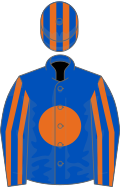| Class | Group 3 |
|---|---|
| Location | Goodwood Racecourse W. Sussex, England |
| Inaugurated | 1829 |
| Race type | Flat / Thoroughbred |
| Sponsor | HKJC World Pool |
| Website | Goodwood |
| Race information | |
| Distance | 5f (1,006 metres) |
| Surface | Turf |
| Track | Straight |
| Qualification | Two-year-olds |
| Weight | 9 st 3 lb Allowances 3 lb for fillies Penalties 5 lb for G1 / G2 winners 3 lb for G3 winners |
| Purse | £100,000 (2025) 1st: £56,710 |
| 2025 | ||
 |  |  |
| Lady Iman | Argentine Tango | Dickensian |
| Previous years | ||
|---|---|---|
| 2024 | ||
 |  |  |
| Big Mojo | Aesterius | Mr Lightside |
| 2023 | ||
 |  |  |
| Big Evs | Purosangue | Kylian |
| 2022 | ||
 |  |  |
| Trillium | Rocket Rodney | Walbank |
| 2021 | ||
 |  |  |
| Armor | Fearby | Boonie |
| 2020-2011 | ||
|---|---|---|
| 2020 | ||
 |  |  |
| Steel Bull | Ben Macdui | Internationaldream |
| 2019 | ||
 |  |  |
| Liberty Beach | Alligator Alley | Show Me Show Me |
| 2018 | ||
 |  |  |
| Rumble Inthejungle | Life of Riley | Soldier's Call |
| 2017 | ||
 |  |  |
| Havana Grey | Invincible Army | To Wafij |
| 2016 | ||
 |  |  |
| Yalta | The Last Lion | Global Applause |
| 2015 | ||
 |  |  |
| Kachy | King Of Rooks | Rouleau |
| 2014 | ||
 |  |  |
| Cotai Glory | Fast Act | Beacon |
| 2013 | ||
 |  |  |
| Brown Sugar | Anticipated | Ambiance |
| 2012 | ||
 |  |  |
| Bungle Inthejungle | Morawij | Hototo |
| 2011 | ||
 |  |  |
| Requinto | Burwaaz | Charles The Great |
| 1990-1988 | ||
|---|---|---|
| 1990 | ||
 |  |  |
| Poets Cove | It's All Academic | Seductress |
| 1989 | ||
 |  |  |
| Haunting Beauty | Red Henry | Boozy |
| 1988 | ||
 |  |  |
| Almost Blue | Paddy Chalk | Konbola |
The Molecomb Stakes is a Group 3 flat horse race in Great Britain open to two-year-old horses. It is run at Goodwood over a distance of 5 furlongs (1,006 metres), and it is scheduled to take place each year in late July or early August.


















































